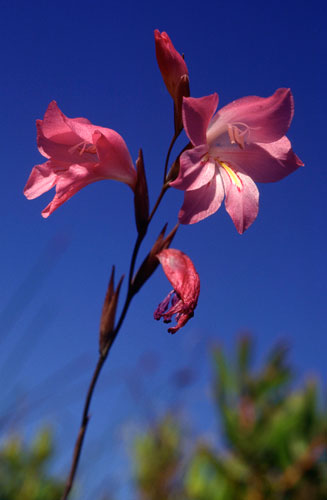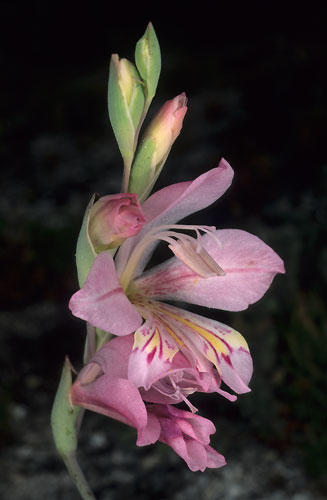|
Gladiolus brevifolius (March pypie, Autumn pipes) Life
> eukaryotes >
Archaeoplastida >
Chloroplastida
>
Charophyta > Streptophytina > Plantae (land plants)
> Tracheophyta (vascular plants) > Euphyllophyta > Lignophyta (woody plants)
> Spermatophyta (seed plants) > Angiospermae (flowering
plants) > Monocotyledons > Order: Asparagales
> Family: Iridaceae > Genus:
Gladiolus
 |
 |
|
Gladiolus brevifolius flowering in winter
on the southern Cape Peninsula, South Africa. [photo
Colin Paterson-Jones ©] |
Gladiolus brevifolius. [photo
H.G.
Robertson, Iziko ©] |
Information is from Goldblatt and Manning (1998).
Distribution and habitat
Endemic to the Western Cape, South Africa, occurring in the
southwestern parts, from Piketberg to the Cape Peninsula and eastwards to the
Agulhas plain and to Montagu. A common autumn flowering species in this region.
Grows in a wide range of soil types from sand to clay.
Life cycle
- A geophyte, with a corm measuring 18-35 mm in diameter.
- Flowers from March to April, sometimes also in February. The leave of
the flowering stem do not have blades, being short and sheathed against the
stem.
- A bladed leaf grows from a separate shoot during the wet winter and it
is this leaf that functions best for photosynthesis.
Ecological interactions
Pollinators
The pollinators feed on the nectar of the flowers and
include:
- bees
- Amegilla fallax
- Amegilla spilostoma
- Allodape sp.
- flies
- Acroceridae > Psilodera valida
Meaning of name
brevifolius is Latin for "short leaves", and refers
to the size of the leaves on the flowering stem.
Publications
- Goldblatt P. and Manning J. 1998. Gladiolus in Southern Africa.
Fernwood Press, Vlaeberg, Cape Town.
- Goldblatt P., Manning J.C. and Bernhardt P. 1997. Notes on the
pollination of Gladiolus brevifolius (Iridaceae) by bees
(Anthophoridae) and bee mimicking flies (Psilodera: Acroceridae).
Journal of the Kansas Entomological Society 70(4): 297-304.
Text by Hamish Robertson
|
